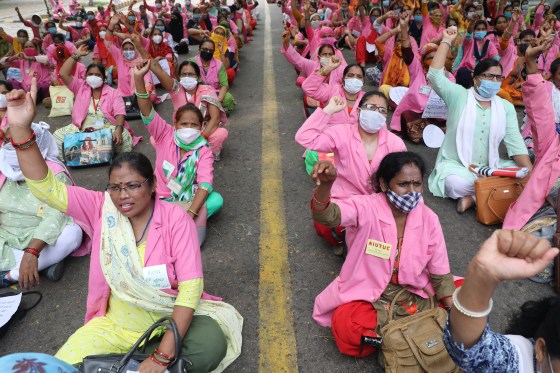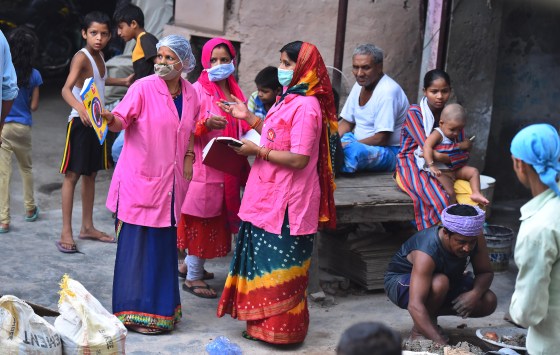One of the more surprising symptoms of COVID-19 has been the blood clots that many patients, including younger ones, have experienced with the infection. The clots have in some cases led to dangerous blockages in the lungs, caused strokes and even death, even in people without a history of circulatory conditions.
In a paper published in Science earlier this week, researchers provide a glimpse into what may be driving the clots triggered by COVID-19 infection. The group found that a specific set of antibodies known as autoantibodies—which are rogue versions of cells meant to defend the body from pathogens, but instead attack its own cells (in this case the body’s own blood vessel cells)—may be partly responsible for the clotting risk associated with the disease. Among 172 patients hospitalized with COVID-19, they found that half produced these autoantibodies. In addition, when the scientists injected the autoantibodies into lab mice, the animals developed blood clots.
In April, the same group of scientists reported that the inflammation associated with COVID-19 can lead to clots in small vessels in the lungs, and that these clots are mostly packed with an immune cell known as a neutrophil. In COVID-19 patients, these neutrophils can explode inside small blood vessels, creating sticky molecular traps that attract other clotting factors circulating in the blood. “Evolutionarily, we think these are meant to trap things like bacteria or viruses,” says Yogen Kanthi, an assistant professor at the University of Michigan, investigator at the National Heart, Lung and Blood Institute and one of the study’s authors. “But if [neutrophils] are over stimulated, they can also grow and cause blockages in blood vessels and drive blood clotting.” In that earlier study, Kanthi and his colleagues found that COVID-19 patients who had more of these “traps” in their blood system were more likely to have severe disease or respiratory failure.
“Inflammation begets clotting, and the clotting leads to more inflammation,” he says. “It becomes a relentless self-amplifying loop of inflammation and clotting that results in patients getting sicker.”
In their latest Science paper, the researchers found that the autoantibodies drive this cycle of inflammation and clotting. The autoantibodies found in the COVID-19 patients are the same ones doctors find in patients with an autoimmune disease called antiphospholipid syndrome, in which antibodies seed clots by attracting clotting factors that eventually block blood flow. Understanding how these antibodies contribute to clotting risk among patients with that syndrome led experts like Jason Knight, who study antiphospholipid disease, to anticipate similar clotting among COVID-19 patients. “By May, clotting was all anyone was talking about with COVID-19 patients,” says Knight, an associate professor of rheumatology at the University of Michigan and one of the study authors. “When we started doing autopsies, we saw microvascular clotting in the lungs.”
Such clotting in small vessels—sometimes too small to even pick up by CT scans—is one of the hallmarks of the blood flow blockages linked to COVID-19. Not only do patients develop so-called macrovascular clots in the bigger vessels including veins and arteries, which can lead to deep vein thrombosis and strokes, but infections also seem to sometimes trigger clots in the tiny vessels in the lungs—which can cause respiratory issues—and the autoantibodies may be the reason for that, since they can bind to blood vessel cells everywhere.
In fact, says Kanthi, COVID-19 can be seen as “an extreme version of a number of diseases, one of them being antiphospholipid syndrome.” That means that studying these patients could lead to better understanding of COVID-19 and how the coronavirus is contributing to clotting. To start, Knight is already studying one drug, dipyridamole, which is approved to treat strokes and prevent blood clots in people who receive mechanical heart valves, to see if it can reduce the risk of clotting in COVID-19 patients. The drug is relatively inexpensive and directly tamps down neutrophil activation, which may in turn reduce the formation of the hyperactive neutrophil traps in the vessels. The test for the autoantibodies is already available for doctors to order, so ultimately, says Knight, COVID-19 patients might be tested for their antibody levels and then triaged to receive more aggressive blood thinners or other medications such as dipyridamole, if it proves effective, to protect them from clotting.
The team is currently enrolling COVID-19 patients for the anti-clotting drug study, and could have answers by the end of the year, says Knight. Those findings could open new understanding into how viruses affect the body’s clotting processes; the fact that the body’s autoantibodies can trigger such widespread clotting is new, says Kanthi. “We knew antibodies like this can exist [from our knowledge of antiphospholipid syndrome] but no one ever looked to see if they can cause clotting.”
It’s not clear yet at what point during the infection these autoantibodies start to form, and what makes people more likely to generate them. Genetics, a person’s history of previous viral and bacterial infections, as well as the revved-up immune response launched by COVID-19 likely all contribute to that risk. But the fact that half of patients may generate these potentially clot-promoting antibodies means that better understanding what these risk factors are, and possibly identifying people who harbor them, may help them from experiencing a more severe and potentially deadly COVID-19 infection.



